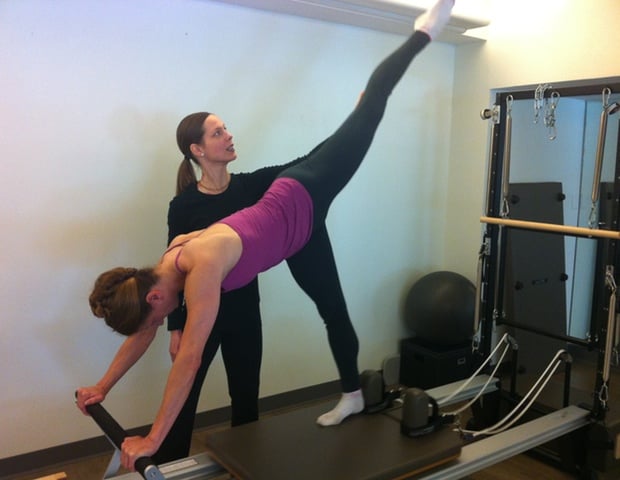As it does for many dancers, Pilates has become a go-to workout for Kristina Windom, a faculty member and guest ballet mistress of the Washington School of Ballet and a former company member of the Washington Ballet, the Cleveland Ballet, and the Washington Opera Ballet. But why exactly do ballet and Pilates work so well together?
After Windom took a few sessions with me on the reformer and jumpboard, I asked her a few questions about her experience with Pilates and why she swears by the method.
When you think about all the movement methods available to us today, where would you place Pilates?
Pilates to me is like the classical ballet of movement therapy. It’s always something I can go back to and rely on when other forms are thrown at me.
How would you describe Pilates for someone who hasn’t done it before?
I would ask this person to imagine [Leonardo] da Vinci’s Vitruvian Man: a circle and a square with profound images of lines going through the center. These series of crosses make up the powerhouse—the core—of movement. And the strongest section of a spider web is in the center!
When and why did you first take interest in Pilates during your career as a ballet dancer?
Unfortunately, Pilates was not offered to me as a student. I didn’t begin mat and equipment work until a few years into my professional career. I would often warm up with Pilates 100s and leg circles before taking a one-and-a-half-hour-class for my day of rehearsals. And I was not the only dancer coming in early to do this. I continue this post-career, too.
As a faculty member of the Washington Ballet working with many students, what difference do you see in your students’ bodies when they add Pilates to their routine?
First and foremost, an awareness. There is a respect and understanding of what the discipline can provide and how Pilates augments their own dance training. I also find that those who are mature enough to understand the benefits Pilates can provide in their dance training will absolutely put that to use. But it does take pre-professional dancers ages 13 and up for this type of awareness to kick in.
Which mat Pilates exercises do you regularly perform as part of your fitness program? Why do you like them?
I do Pilates mat for 15 minutes five days a week. That usually includes hundreds, single and double leg circles, and bridges. I like to access the core as quickly as possible and mat work is my body’s first cup of coffee. The response is instantaneous.
When you transitioned from being a professional ballerina to a faculty member of the Washington Ballet School, how did Pilates support the change your body went through?
Pilates is an old trusted friend, so as I transitioned to fewer ballet classes per week, my body was fine with the change. Doing ballet for so many years gave me an extremely strong muscle memory for execution of almost anything. Once I got over the initial “things feel different in a 30-year-old body than they do in a 20-year-old body” as a mature dancer, I relied on a stronger Pilates and yoga practice. I got frustrated at times, but I felt that I trusted my Pilates practice enough to satisfy my craving for correction, movement, and transition.
What benefits do you expect from Pilates routines?
I expect that what I put into it, I get out of it. If I’m conservative in my practice it means I need to focus on a few areas. If I want to be challenged, I certainly can find that in my routine. Pilates training is a strong voice in my body.
Timea Presley is the head Pilates instructor at Mint in Dupont Circle. She trained as a contemporary and modern dancer at the Berlin Contemporary Dance Academy and moved to Washington, DC, in 2005.


















